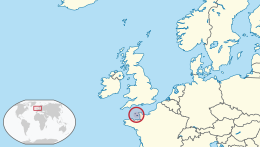
Back Pulo-pulo Channel ACE Kanaaleilande Afrikaans Islas Anglonormandas AN جزر القناة الإنجليزية Arabic جزر القنال الانجليزى ARZ Islles Anglonormandes AST Normand adaları Azerbaijani Нармандскія астравы Byelorussian Нармандзкія астравы BE-X-OLD Нормандски острови Bulgarian
 Satellite photograph of the Channel Islands in 2018 | |
 Location of the Channel Islands | |
| Geography | |
| Location | Northwestern Europe |
| Coordinates | 49°25′48″N 02°21′00″W / 49.43000°N 2.35000°W |
| Adjacent to | English Channel |
| Total islands | 7 inhabited |
| Major islands | |
| Area | 198 km2 (76 sq mi) |
| Highest point | Les Platons |
| Administration | |
| Capital and largest settlement | Saint Peter Port, Guernsey |
| Area covered | 78 km2 (30 sq mi; 39.4%) |
| Capital and largest settlement | Saint Helier, Jersey |
| Area covered | 118 km2 (46 sq mi; 59.6%) |
| Demographics | |
| Demonym | Channel Islander Channelean |
| Population | 171,916[1][2] (2021) |
| Pop. density | 844.6/km2 (2187.5/sq mi) |
| Additional information | |
| Time zone | |
| • Summer (DST) | |
| Internet TLD = GG and JE | |
The Channel Islands[note 1] are an archipelago in the English Channel, off the French coast of Normandy. They are divided into two Crown Dependencies: the Bailiwick of Jersey, which is the largest of the islands; and the Bailiwick of Guernsey, consisting of Guernsey, Alderney, Sark, Herm and some smaller islands. Historically, they are the remnants of the Duchy of Normandy. Although they are not part of the United Kingdom,[3] the UK is responsible for the defence and international relations of the islands as it is for the other Crown Dependency, the Isle of Man, and the British Overseas Territories.[4] The Crown Dependencies are neither members of the Commonwealth of Nations, nor part of the European Union. They have a total population of about 171,916, and the bailiwicks' capitals, Saint Helier and Saint Peter Port, have populations of 33,500 and 18,207 respectively.
"Channel Islands" is a geographical term, not a political unit. The two bailiwicks have been administered separately since the late 13th century. Each has its own independent laws, elections, and representative bodies (although in modern times, politicians from the islands' legislatures are in regular contact). Any institution common to both is the exception rather than the rule.
The Bailiwick of Guernsey is divided into three jurisdictions – Guernsey, Alderney and Sark – each with its own legislature. Although there are a few pan-island institutions (such as the Channel Islands Brussels Office, the Director of Civil Aviation and the Channel Islands Financial Ombudsman,[5] which are actually joint ventures between the bailiwicks), these tend to be established structurally as equal projects between Guernsey and Jersey. Otherwise, entities whose names imply membership of both Guernsey and Jersey might in fact be from one bailiwick only. For instance, The International Stock Exchange is in Saint Peter Port and therefore is in Guernsey.
The term "Channel Islands" began to be used around 1830, possibly first by the Royal Navy as a collective name for the islands.[6]: 158 The term refers only to the archipelago to the west of the Cotentin Peninsula. Other populated islands located in the English Channel, and close to the coast of Britain, such as the Isle of Wight, Hayling Island and Portsea Island, are not regarded as "Channel Islands".
- ^ "World Population Prospects 2022". United Nations Department of Economic and Social Affairs, Population Division. Retrieved 17 July 2022.
- ^ "World Population Prospects 2022: Demographic indicators by region, subregion and country, annually for 1950-2100" (XSLX) ("Total Population, as of 1 July (thousands)"). United Nations Department of Economic and Social Affairs, Population Division. Retrieved 17 July 2022.
- ^ "Royal.gov.uk". Royal.gov.uk. Archived from the original on 21 September 2012. Retrieved 4 October 2012.
- ^ "Fact sheet on the UK's relationship with the Crown Dependencies" (PDF). Gov.uk. Ministry of Justice. Archived (PDF) from the original on 9 December 2014. Retrieved 14 February 2016.
HM Government is responsible for the defence and international relations of the Islands.
- ^ "Channel Islands Financial Ombudsman".
- ^ Graham, Richard (2015). At their Majesties' Service. Gateway Publishing. ISBN 9781902471129.
Cite error: There are <ref group=note> tags on this page, but the references will not show without a {{reflist|group=note}} template (see the help page).